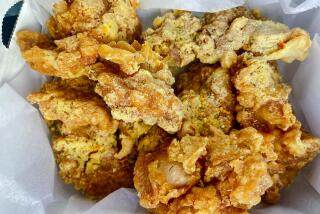Combo dishes with caution on the side?
- Share via
These days, restaurant chains across America are offering traditional favorites fused into hearty combos like bacon cheeseburger pizzas, lasagna with meatballs and buffalo-chicken-stuffed quesadillas.
Although consumers take to these entrees, health and nutrition advocates call them “hybrid horribles.”
Consider the Uno Chicago Grill chain. It sells an amalgamation of pizza, mashed potatoes, bacon, cheddar cheese and sour cream that packs 2,060 calories, 48 grams of saturated fat and 3,140 milligrams of sodium.
Not even the restaurant expects this appetizer to wind up in just one stomach. But even shared by two, it’s a huge proportion of the 2,000 to 2,500 calories recommended for the average diner for an entire day.
Uno defended its menu, noting that the Pizza Skins appetizer should be shared and that by May it will have removed artery-clogging trans fat from its menu.
But to Michael Jacobson, executive director of the Center for Science in the Public Interest, these offerings “are seemingly designed to promote obesity, heart disease and stroke.”
His nonprofit health organization gained a reputation as the “food police” in the 1990s, when it declared fettuccine Alfredo “a heart attack on a plate.”
Some California lawmakers share Jacobson’s concern. Next month, hearings are scheduled for two bills that would require more extensive nutritional labeling on restaurant menus.
A bill by state Sen. Carole Migden (D-San Francisco) would require restaurant chains with five or more establishments in the state to include calorie counts on printed menus and menu boards.
Another, from state Sen. Alex Padilla (D-Pacoima), requires menus to also include fat and carbohydrate grams and sodium milligrams. His bill applies to chains with 10 or more locations.
“Go into a supermarket and every package of food has that information, but if you go into a restaurant, [it’s] just not there,” Padilla said. “I don’t want to ban anything. I just want to make sure that consumers have the information they need to make correct decisions.”
Printing nutrition information on menus would discourage diners from ordering such delicacies as Ruby Tuesday’s Colossal Burger, with 1,940 calories and 141 grams of fat, or Cheesecake Factory’s Chris’ Outrageous Chocolate Cake, a combination of brownie, pie and cheesecake that packs 1,380 calories, said Margo Wootan, nutrition policy director at the Center for Science in the Public Interest.
Having just one of those items would swamp the eater’s daily calorie requirement, which is about 2,000 for women and 2,500 for men, Wootan said.
California eateries are concerned about “how these rules would be applied” but will work with lawmakers to craft legislation “acceptable to the industry” as well as labeling advocates, said Jot Condie, president of the California Restaurant Assn.
*
(BEGIN TEXT OF INFOBOX)
Beyond supersizing
The Center for Science in the Public Interest found that many sit-down restaurant items have more calories, fat and salt than fast-food sandwiches.
*--* Fat Saturated Item, restaurant Calories (In grams) fat Fresh Chicken & Broccoli Pasta, 2,061 128 77-90* Ruby Tuesday Pizza Skins,** Uno Chicago Grill 2,060 134 48 Colossal Burger, Ruby Tuesday 1,940 141 71-106* Ranchilada, On the Border 1,870 NA 46 Double-Stacked Club Quesadilla, 1,860 123 52 On the Border Founder’s Favorite, 1,740 NA 48 Coldstone Creamery Chris’ Outrageous Chocolate Cake, 1,380 NA 33 Cheesecake Factory Twice-Baked Lasagna With 1,360 NA 38 Meatballs, Romano’s Macaroni Grill For comparison Whopper, Burger King 670 39 11 Big Mac, McDonald’s 540 29 10 Turkey breast 280 4.5 1.5 sandwich (6-inch), Subway
*--*
--
*Estimated
**The restaurant says this should serve two people.
Sources: Center for Science in the Public Interest, Times research
Los Angeles Times
More to Read
Eat your way across L.A.
Get our weekly Tasting Notes newsletter for reviews, news and more.
You may occasionally receive promotional content from the Los Angeles Times.











